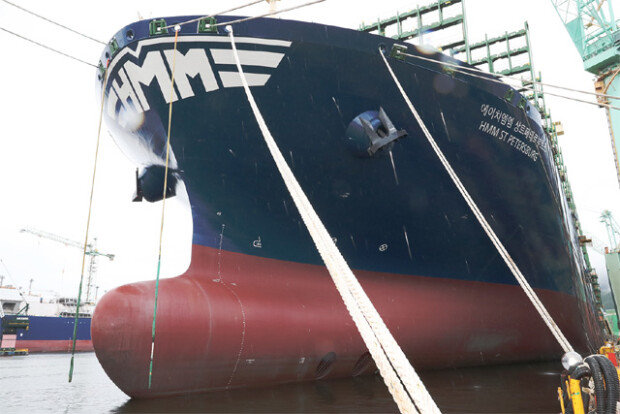HMM swings to surplus after 20 quarters of deficit
HMM swings to surplus after 20 quarters of deficit
Posted August. 13, 2020 07:33,
Updated August. 13, 2020 07:33

The final inspection of an ultra-large container vessel (ULCV) with “HMM St. Petersburg” written on side was underway in a heavy rain on Tuesday at the Geoje Shipyard of Samsung Heavy Industries in South Gyeongsang Province.
The 400-meter long, 61-meter wide and 400-meter high St. Petersburg is the world’s largest vessel that is capable of carrying 24,000 containers at once. The vessel, which has been commissioned by the only Korea-based large shipping company HMM (formerly known as Hyundai Merchant Marine), is set to sail around the world from next month, covering the Busan-to China-to-Europe route.
“The name St. Petersburg represents our aspiration to regain our competitiveness in European routes by rebuilding the domestic shipping industry, which has been stagnant since 2016,” said an HMM official.
After 20 straight quarters of deficit, HMM has signaled a rebound of the domestic shipping industry by posting a surplus in the second quarter of the year.
In a public announcement on Wednesday, HMM said it swung to surplus by posting an operating profit of 138.7 billion won in the second quarter. It is surprising results considering the company’s operating loss of 112.9 billion won in the same period of last year. The better-than-expected result is encouraging given that it is attributable to a painful restructuring the company underwent in 2016 amid the change of majority shareholder from Hyundai Group to KDB Development Bank. Although HMM recorded 1.3751 trillion won in sales, down 1.6 percent from the same period last year, the company achieved an economy scale by deploying ULCVs and succeeded in cost-cutting.
Despite a slight drop in global cargo volume due to the COVID-19 pandemic, HMM is continuing a full-load operation. It is also encouraging that the reduced global shipping operation is showing signs of an upturn in the second half of the year on the back of an increase in oil and iron ore demands in the winter. In addition, HMM is planning to raise the share of ULCV to 40 percent of the total. Twelve 24,000 TEU vessels will be delivered in September and eight more 16,000 TEU vessels in the first half of next year. The figure is twice as high as top global shipping companies, considering that the ratio of ULCVs for Maersk and MSC, the world’s largest and second-largest shipping company, respectively, is around 20 percent. “We’ll become a small but strong company,” said an HMM official. The company aims to increase its TEU capacity to 1.1 million by 2022.
jjy2011@donga.com · soon9@donga.com






